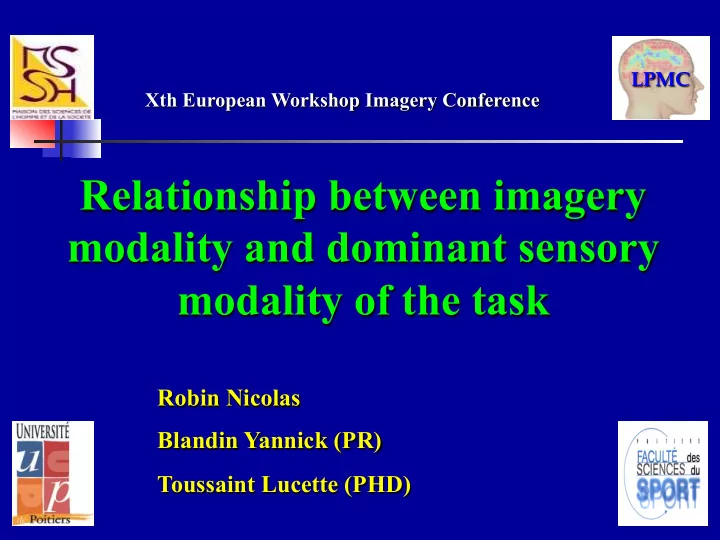

LPMC Xth European Workshop Imagery Conference Relationship between imagery modality and dominant sensory modality of the task Robin Nicolas Blandin Yannick (PR) Toussaint Lucette (PHD)
Introduction Definition (Decety, 1996) => Feltz & Landers (1983) Functional equivalence between imagery and physical practice (Decety, 1996; Jeannerod, 1999) • Mental chronometry (Guillot & Collet, 2004) • Autonomic responses (Roure and al., 1999) • Neural activity (Jeannerod, 2001) • Sensory Integration ? => Postulated
Sensory modality evolution during physical practice Specificity of practice hypothesis (Tremblay & Proteau., 1998). Determination of the dominant modality: Visual (V) or Kinesthetic (K) to ensure an optimal performance => function of task constraints. • V Dominance: early => Aiming task (Proteau & Carnahan, 2001). • K Dominance: more time => Aiming towards self defined targets (Robin and al., 2004).
Previous research in imagery • K dominant task (simple angular configuration reproduction task): KI > VI (temporary decrement). • V dominant task (laser aiming task): VI > KI (stable) (Robin, Toussaint, Blandin, Proteau, submitted).
Aim of the studies Investigate, the role of KI and VI as a function of: • constraints of the task • amount of imagery practice
Hypothesis (predictions) • K dominant task: KI > VI and control, but the extraction and utilisation of K (dominant information) would need a lot of practice. • V dominant task: VI > KI and control, early V treatments.
Utility of mixed imagery groups Mixed imagery group (MI=VI+KI) used to evaluate (early/late) extraction and privileged sensory dominant modality treatments hypothesis.
• Exp 1: K dominant task • Exp 2: V dominant task VI KI r o r r E MI MI KI VI
Experiment 1 Kinesthetic dominant task
Method Participants • 40 participants (21 men and 19 women, mean age: 23,4 years, SD = 2,9 years), right podale laterality. • Movement Imagery Questionnaire (MIQ, Hall & Pongrac, 1983), scores < 19. => only « good imagers » selected
Material Material
Material
Dependant variable: absolute repositioning error (degrees) Recall Recall phase phase Encoding Encoding phase phase
Procedure Tests 1 Acquisition 1 Acquisition 2 Tests 3 and 4 Test 0 and 2 (15 trials) (150 trials) (15 trials) (15 trials) (15 trials) Kinesthetic Imagery Kinesthetic Imagery (KI) (KI) Visual Imagery (VI) Visual Imagery (VI) K K K Mixed Imagery (MI) Mixed Imagery (MI) Neutral task Neutral task (control) (control)
VI: imagine reaching the position asked by the experimenter focussing on the visual information. KI: feel reaching the position focussing on the kinesthetic information. MI: simultaneously visually imagine and feel themselves reaching the position.
Tests 1 Acquisition 1 Acquisition 2 Tests 3 and 4 Test 0 and 2 (15 trials) (150 trials) (15 trials) (15 trials) (15 trials) Kinesthetic Imagery Kinesthetic Imagery (KI) (KI) Visual Imagery (VI) Visual Imagery (VI) K K K Mixed Imagery (MI) Mixed Imagery (MI) Neutral task Neutral task (control) (control)
Dependant variable: absolute repositioning error (degrees) Anova: Groups x Tests Results Significative interaction: F (12, 144) = 10.63, p < .001 KI 150 imagery 15 imagery trials VI trials 4 MI 3.6 Control Absolute error (degrees) 3.2 2.8 2.4 * 2 1.6 * 1.2 0.8 0.4 0 Test 0 Test 1 Test 2 Test 3 Test 4 Experimental phases
Discussion • KI group need more than 15 imagery trials to increase and stabilise the performance. After 150 imagery trials KI > VI and Control (stable). • Late extraction of dominant sensory information (K) = aiming task towards self defined targets (Robin et al., 2004).
Discussion • What about the MI group? => MI = KI • Result of this K dominant task is in favour of validation that the specificity of practice hypothesis is valid for mental practice: => exclusive treatment of K information during MI.
Experiment 2 Visual dominant task
Method Participants • 40 participants (22 men and 18 women, mean age: 22,8 years, SD = 2,7 years), right podale laterality. • Movement Imagery Questionnaire (MIQ, Hall & Pongrac, 1983), scores < 19. => only « good imagers » selected
Material
Procedure Tests 1 Acquisition 1 Acquisition 2 Tests 3 and 4 Test 0 and 2 (15 trials) (150 trials) (15 trials) (15 trials) (15 trials) Kinesthetic Imagery Kinesthetic Imagery (KI) (KI) V V V Visual Imagery (VI) Visual Imagery (VI) + + + Mixed Imagery K K K (MI) Mixed Imagery (MI) Neutral task Neutral task (control) (control)
Anova: Groups x Tests Significative interaction: Results F (12, 144) = 5.31, p < .001 KI 150 imagery 15 imagery trials VI trials 3.6 MI Absolute error (degrees) 3.2 Control 2.8 2.4 2 * 1.6 1.2 * 0.8 0.4 * 0 Test 0 Test 1 Test 2 Test 3 Test 4 Experimental phases
Discussion • VI (transitorily) > KI and Control groups after 15 imagery trials, confirmed after 150 trials. • Early extraction of dominant sensory information (V) = aiming task towards visible targets (Proteau & Carnahan, 2001).
Discussion • What about the MI group? => VI > MI (intermediate performance) • Validation of the specificity of practice hypothesis?
Conclusion • The results of experiments 1 and 2 indicated that it is necessary to maintain constant sensory dominant modality of the task and imagery modality during mental practice. Constraints of the task or previous experience of the task effects?
Thank you for your attention I would be happy to answer your questions I ’ m looking for a post-doctoral formation opportunity and I ’ m open to all propositions.
Recommend
More recommend